
G E T O N T...
G E T O N T H E M I L K C R AT E ! FOCUS: STAGE 5 Year 9 Unit of Work: Get on the Milk Crate! FOCUS QUESTION: HOW DO WE PERSUADE PEOPLE TO AGREE WITH US? RATIONALE This unit of work explores persuasive language in written and the spoken forms and focuses on the way composers use language appropriate to purpose, audience and situation. This study will focus on speech transcripts, speaking skills, rhetorical devices, debating, persuasive techniques, the construction of arguments and the presentation of issues in the media. SYLLABUS OUTCOMES CURRENT OUTCOMES 1, 2, 4, 5, 6, 7, 9, 11 NEW OUTCOMES 1, 1.1, 1.2, 1.5, 1.6, 1.9, 1.11, 1.12, 1.13, 1.15, 1.16, 1.17, 1.18 2, 2.9, 2.10, 2.11, 2.12, 2.13, 2.14, 2.17, 2.18, 2.19, 2.20, 2.21, 2.22 4, 4.1,4.2,4.8, 4.9, 4.11, 4.12, 4.13, 4.10, 4.19, 4.20, 4.21 8 8.4, 8.5, 8.6, 8.7 Focus on Persuasive Language: Rhetorical Devices and Persuasive Techniques (1.1, 1.5, 1.6, 1.9, 1.11, 1.12, 1.17, 1.18, 2.14, 2.17, 2.9, 2.10, 2.19, 2.20, 4.2) PowerPoint with activities e.g. Persuasive Language Bingo Truth for Who? Thinking Activity – difference between fact and opinion Ethos, Pathos, Logos: View Gruen Transfer “Head and Shoulders Ad analysis” What do the panel point out about the persuasive nature of advertising? Group activity: how would you add pathos to this advertisement? Extension: You are the new panel for The Gruen Transfer. Analyse and present a panel discussion on an advertisement (2.11, 2.12, 2.13) TASK - KEY WORDSLINK THE WORD TO ITS MEANING Persuade To exaggerate Audience To attract / to grab interest Appeal to The reason for writing Hyperbole Repeating certain words / phrases / ideas Direct Address To give orders e.g. “Don’t… Come …” Emotive Language Rhetoric Persuasive Language Words that evoke emotion The people the writing is aimed at Use of “you” to involve audience Purpose A question that doesn’t need an answer, e.g. Dare you ride the Big Dipper? Repetition / lists / tripling To make somebody believe you Commands Rhetorical question The art of persuasion and making people to think/feel in a particular way Language used to persuade LET’S PLAY BINGO! Draw a grid like the one below and choose 9 of the following words to write in each box in any order you wish … Persuade Audience Appeal to Hyperbole Direct Address Emotive Language Rhetoric Persuasive Language Purpose Repetition / lists / tripling Commands Rhetorical question Logos Ethos Pathos ‘TRUE FOR WHO’ VISUAL THINKING ROUTINE A routine for exploring truth claims from different perspectives 1. Discuss. What kind of situation was the claim made in? (Who made it? What were people’s interests and goals? What was at stake?) 2. Brainstorm. Make a list of all the different points of view you could look at this claim from. 3. Dramatize. Choose a viewpoint to embody and imagine the stance a person from this viewpoint would be likely to take. Would he or she think the claim is true? False? Uncertain? Why? Go around in a circle and dramatically speak from the viewpoint. Say: • My viewpoint is… • I think this claim is true/false/uncertain because… • What would convince me to change my mind is… 4.Stand back. Step outside of the circle of viewpoints and take everything into account: What is your conclusion or stance? What new ideas or questions do you have? Purpose: What kind of thinking does this routine encourage? The True for Who? routine helps students cast a wide net for facts and arguments by imagining how an issue looks from different points of view. The routine also helps students see how different viewpoints and situations might influence the stances people are likely to take. http://pzweb.harvard.edu/vt/VisibleThinking_html_ files/03_ThinkingRoutines/03f_TruthRoutines/TugF orTruth/TugForTruth_Routine.html THE POWER OF ADVERTISING: THE GRUEN TRANSFER AD OF THE WEEK What do the panel point out about the persuasive nature of advertising? http://www.youtube.com/watch?v=4Eh1Fc3j 83A Group Activity: How would you add pathos to this advertisement? • Imagine that you are the producers of the Head and Shoulders ad shown on ‘The Gruen Transfer’s Ad of the Week’. • You are concerned that some viewers felt that the advertisement lacked ‘the human element’ – emotion. • Create THREE sequences to add to the advertisement that would create a sense of pathos. Extension: You are the new panel for The Gruen Transfer. Analyse and present a panel discussion on an advertisement (2.11, 2.12, 2.13) Presentation of Issues in the Media (2.18, 2.19, 4.1, 4.8, 4.19, 4.20. 4.21 ) • Teacher modelling of how different texts present views of a current media issue. • Outline key forms in the media, e.g. feature article, letters, editorials, talk back, blogs, etc. • Close analysis of language used in persuasive texts: sentence structure, vocabulary choice, abstract nouns, nominalisation. • What is the form of the text? • What issue(s) / event(s) is/are being presented in the text • What point of view is being argued in the text? Find evidence to show this. • What techniques are being used by the composer of the text to persuade or position the responder? Discuss how it seeks to persuade. NOMINALISATION Sentences can be written in a number of different ways to create language that ranges in style from informal to very formal. When a verb is nominalised, it becomes a concept rather than an action. As a consequence, the tone of your writing will sound more abstract and also more formal; for example: We walked for charity. We raised money for the Leukemia Foundation. The charity walk raised money for the Leukemia Foundation. NOMINALISATION EXAMPLE We analysed the data from the experiment, and it revealed that children react when they have too much sugar. (Active voice) REWRITTEN IN NOMINALISED FORM The analysis of the data revealed children's reaction to excessive sugar intake. NOMINALISATION The nouns formed as a result of nominalisation are highlighted in one colour, while the verbs they replace are highlighted in another colour text). Crime was increasing rapidly and the police were becoming concerned. The rapid ____?____ in crime was causing concern among the police. Germany invaded Poland in 1939. This was the immediate cause of the Second World War breaking out. Germany's ____?_____of Poland in 1939 was the immediate cause of the outbreak of the Second World War. Getting on the Milk Crate: establishing an argument (1.2, 1.13, 2.22, 8.6) Blogs and Twitter and Social Media - Globalisation of opinions – empowering or destructive? Do the marginalised now have a voice? Tug of Truth activity Mobile Phone Technology – expressing our ideas in live and virtual situations. – - View and analyse: “No Man Is an Island” Tropfest short film - Explore power of Mobile technology in current affairs and the media – web quest then Circle of Viewpoints – Is this a good development? Ravo Values Exchange - Exloring case study (5 topic areas, choose one which will become their assessment focus) – conducting surveys, on-line research of differing opinions, sharing opinions PERSUASION IN THE DIGITAL AGE “Persuasion (in its various forms) and the way in which it is taught in schools could do with a serious extension to include the ways in which it works online. There is a considerable array of persuasive texts, processes and digital products available to teachers for use in the classroom once they are aware of how it all works in this context and have the language to deal with it.” Prue Green, ‘Persuasion in Digital Contexts’ CYBER SOAPBOX An examination of the internet and social networking sites as platforms to allow the expression of free speech and an analysis of how social media manipulate and persuade responders BLOGS, TWITTER AND SOCIAL MEDIA everyone tweet their favorite causes and hashtag #HappyWorldHumanitarianDay so many great causes out there working to #makeachange. #proud THE POWER OF SOCIAL MEDIA: GLOBALISATION OF OPINIONS – EMPOWERING OR DESTRUCTIVE? DO THE MARGINALISED NOW HAVE A VOICE? http://www.russellbrand.tv/ http://www.telegraph.co.uk/technology/twitter/8691663/London-riots-Twitter-says-alltweets-must-continue-to-flow.html http://rw-3.com/2011/02/twitter-revolutions-and-middle-eastern-culture/ http://www.victorystore.com/wordpress/?p=8 http://www.guardian.co.uk/world/2011/apr/04/barack-obama-twitter-facebook-election TUG FOR TRUTH VISUAL THINKING ROUTINE 1. Identify a question of truth -- a controversial claim that something is true or false -- where you know there is some evidence on both sides that students can bring forward. 2. Ask students if they have an opinion about it (it's okay not to have one). 3. Draw a tug of war diagram on the board (or tape a piece of rope on the wall and use Postits to make it more dramatic). Explain that students can add two kinds of things. One is evidence -- tugs in the Yes, True direction or the No, False direction. The other thing to add is a question about the tug of war itself, a question that asks for more information or about "what if" we tried this or we tried that, what would the results be? 4. Finish the lesson by asking students what new ideas they have about the question of truth. Can we decide now? Do some people lean one way and some the other? Is the best answer in a "gray area" -- most of the time true but not always, or half the time? How could we settle it if we had to? http://pzweb.harvard.edu/vt/VisibleThinking_html_fil es/03_ThinkingRoutines/03f_TruthRoutines/TugForT ruth/TugForTruth_Routine.html HTTP://RAVENSWOOD.VALUES-EXCHANGE.COM/ Speaking and Listening skills (1.5, 2.21, 1.16, 2.13, 2.11, 2.12, 4.1. 4.9, 4.11, 4.12, 4.13, 8.4, 8.5, 8.7 ) Drama activities and exercises to foster students’ speaking and listening skills and techniques; for example: Voice: activities to consider tone, volume, clarity, modulation. Gestures / eye contact (Mirroring activity) Formal / informal language Listening activities from Lend me your Ears: Listening Carefully and Critically Analysing speech transcripts and presentations, identifying purpose, audience, structure, and persuasive and rhetorical techniques used. Students should also evaluate the effectiveness of speeches. Students write and deliver own speeches (to be formally assessed) – students may use flip cameras to prepare for assessment task and for self-evaluation and peer evaluation of performances. Speaking and Listening skills (1.5, 2.21, 1.16, 2.13, 2.11, 2.12, 4.1. 4.9, 4.11, 4.12, 4.13, 8.4, 8.5, 8.7 ) Drama activities and exercises to foster students’ speaking and listening skills and techniques; for example: Analysing speech transcripts and presentations, identifying purpose, audience, structure, and persuasive and rhetorical techniques used. Students should also evaluate the effectiveness of speeches Students write and deliver own speeches (to be formally assessed) – students may use flip cameras to prepare for assessment task and for self-evaluation and peer evaluation of performances. PROBLEMS ENCOUNTERED Prescriptive nature of outcomes (“literary texts”) does not allow for ‘learn to’ to be achieved via a variety of text types. The use of the term “AUTHOR” was problematic and it was questionable as to whether author and composer were interchangeable terms. The task of re-programming looks daunting; however, it is just a matter of reshaping. Many outcomes can be covered by the activities included in current programmes. Mapping activities to specific outcome dot points can help to see that all outcomes have been fulfilled across stages.
© Copyright 2025



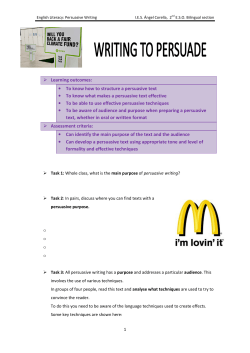

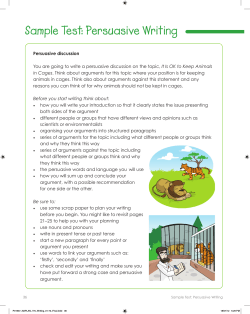



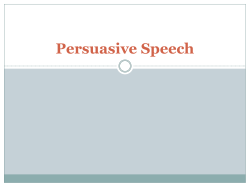
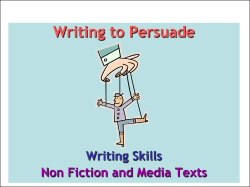

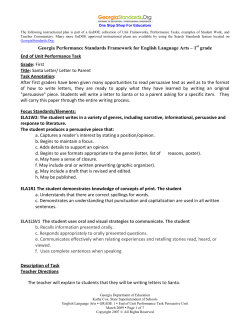
![Persuasive Writing Writing and Grammar: Publishers, 2001] Communication in Action](http://cdn1.abcdocz.com/store/data/000386455_1-5301f4c832f9f35d5635f871317f637d-250x500.png)
